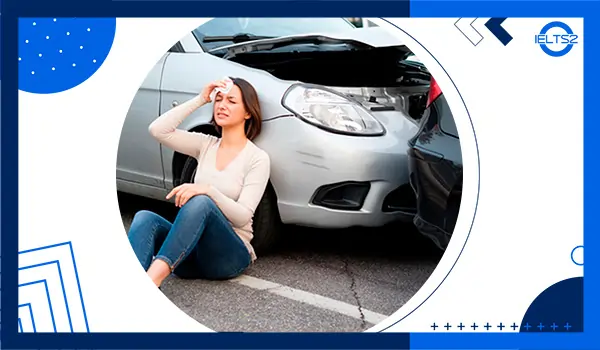نمونه سوالات اسپیکینگ آیلتس درباره تصادفات جاده ای (پارت 1 2 3)
در این بخش بیش از 20 مورد از نمونه سوالات اسپیکینگ آیلتس نمره 9 درباره “موضوع تصادفات جاده ای” را با هم میبینیم. این مجموعه از آخرین سوالات گزارش شده از سنترهای برگزار کننده آیلتس در ایران و خارج از کشور مربوط به پارت 1، 2 و 3 می باشند و شانس تکرار آن ها در آینده بالاست. در ادامه مطلب همچنین نکات گرامری، لغات و دلایل دریافت نمره 9 را به طور مشخص توضیح داده ایم تا راهنمایی برای علاقمندان باشد. 1000 نمونه سوالات اسپیکینگ آیلتس با جواب PDF پارت 1 2 3 پیشنهاد بعدی ما به شما عزیزان است.
نمونه سوالات اسپیکینگ آیلتس درباره موضوع تصادفات جاده ای (پارت 1)
1. Do you think road accidents are preventable?
Yes, I firmly believe that road accidents are largely preventable if proper measures are taken by both authorities and individuals. Strict enforcement of traffic laws, improved road infrastructure, and public awareness campaigns can significantly reduce the incidence of accidents. Moreover, advanced vehicle safety features and driver education programs play essential roles in minimizing risks. By adopting a comprehensive approach that combines regulation, education, and technology, communities can create safer driving environments and dramatically decrease the occurrence of road accidents effectively.
2. What factors do you think contribute to road accidents?
There are several factors that contribute to road accidents, including human error, poor road conditions, and vehicle malfunctions. Distracted driving, speeding, and driving under the influence further exacerbate the situation. Additionally, inadequate traffic management and lack of proper signage can confuse drivers, leading to collisions. Environmental factors such as heavy rain, fog, and icy roads also increase accident risks. Addressing these issues requires a combination of stricter enforcement of laws, better infrastructure, and continuous public education on safe driving practices.
3. How can driver behavior be improved to reduce accidents?
Improving driver behavior is essential for reducing road accidents. Effective measures include comprehensive driver education programs that emphasize defensive driving techniques and situational awareness. Regular training sessions and public awareness campaigns can help individuals understand the consequences of risky behavior. Additionally, stricter enforcement of traffic laws and monitoring systems encourage adherence to safe driving practices. By cultivating a culture of responsibility and continuous learning, drivers can become vigilant and respectful on the roads, reducing the frequency and severity of accidents.
4. What role does public awareness play in preventing road accidents?
Public awareness plays a critical role in preventing road accidents by educating drivers and pedestrians about safe practices. Campaigns through media and community programs disseminate essential information regarding road safety, highlighting the dangers of speeding, distracted driving, and impaired behavior. Increased awareness encourages individuals to adopt responsible driving habits and remain cautious in various traffic situations. Consequently, informed citizens contribute to a culture of safety, ultimately reducing accident rates and creating more secure environments for everyone on the roads significantly.
5. How does vehicle maintenance affect road accident rates?
Regular vehicle maintenance is crucial for reducing road accident rates. Ensuring that brakes, tires, lights, and engine components are in proper working condition minimizes the risk of mechanical failure on the road. Routine inspections and prompt repairs can prevent unforeseen breakdowns that might lead to dangerous situations. In addition, well-maintained vehicles are more reliable, building driver confidence and contributing to safer driving practices. Consistent maintenance not only extends the lifespan of vehicles but also enhances overall road safety significantly remarkably.
6. Do you believe stricter traffic laws can reduce road accidents?
I strongly believe that stricter traffic laws can reduce road accidents. By enforcing penalties for speeding, reckless driving, and impaired behavior, authorities can deter dangerous actions on the road. Enhanced surveillance and stricter licensing requirements further contribute to safer driving environments. When drivers are aware of severe consequences, they are more likely to follow rules diligently. This approach, combined with public education and infrastructure improvements, creates a comprehensive system that promotes responsible driving and minimizes the risk of collisions significantly.
7. What impact do weather conditions have on road safety?
Weather conditions significantly impact road safety by altering driving conditions and increasing risks. Heavy rain, fog, and snow reduce visibility and make road surfaces slippery, leading to longer braking distances and reduced vehicle control. These conditions demand extra caution and slower speeds. Additionally, extreme weather can cause sudden hazards such as flooding or icy patches. As a result, drivers must adapt their behavior to account for adverse weather, thereby ensuring that safety remains a top priority during challenging driving circumstances.
8. Can technological advancements in cars help reduce accidents?
Technological advancements in modern cars greatly reduce accidents. Features like automatic braking, lane departure warnings, and collision avoidance enhance driver responses. These innovations compensate for human errors by providing extra safety layers. Additionally, real-time data analytics and connectivity improve traffic management and emergency responses. As technology evolves, further improvements in vehicle safety are expected, leading to a notable decline in accident rates and ensuring a safer driving experience for all road users. This progress significantly boosts overall public road security.
9. What measures can local governments take to improve road safety?
Local governments can implement a range of measures to improve road safety. Upgrading road infrastructure, installing clear signage, and creating dedicated lanes for various vehicles are effective strategies. Authorities may also enforce stricter traffic laws and invest in public awareness campaigns. Regular road maintenance and efficient emergency response systems further contribute to safety. By adopting a comprehensive approach that combines regulation, infrastructure, and education, local governments can substantially lower accident rates and create a safer, more reliable transportation network overall.
10. How important is emergency response in managing road accidents?
Emergency response plays a crucial role in managing road accidents, as timely intervention can reduce injury severity and save lives. Rapid medical assistance, rescue operations, and coordinated efforts among emergency services improve the outcomes for accident victims. Well-trained first responders, equipped with communication systems, ensure prompt arrival of help. Moreover, improvements in emergency protocols and infrastructure further enhance response effectiveness. Overall, a robust emergency response system is indispensable in mitigating the adverse impacts of road accidents and promoting public safety.
نمونه سوالات اسپیکینگ آیلتس درباره موضوع تصادفات جاده ای (پارت 2)
Describe a road accident you witnessed or experienced. You should say:
When and where it happened
What exactly occurred
How you felt about it
And explain how this incident has influenced your perspective on road safety.
I vividly recall a road accident that profoundly impacted my perspective on life and safety. It occurred three years ago on a stormy winter evening as I was driving along a rural highway near my hometown. The weather conditions were treacherous; heavy snowfall and icy roads made every turn unpredictable. Suddenly, a car traveling in the opposite direction lost control and slid into the lane. In an instant, the vehicles collided, producing a chaotic scene of twisting metal and shattered glass. I was fortunate to be at a safe distance, yet the incident shook me to my core.
Immediately after witnessing the accident, I pulled over and dialed emergency services. I observed as paramedics and police officers rushed to the scene with remarkable urgency and efficiency. Their coordinated efforts to rescue the injured and secure the area were both inspiring and heart-wrenching. This experience forced me to confront the harsh reality that even a minor lapse in concentration can have catastrophic consequences on the road. I felt a mix of shock, sorrow, and an overwhelming determination to never take my safety lightly again.
In the weeks following the accident, I reflected deeply on what had happened. I began to appreciate the critical importance of defensive driving and strict adherence to traffic rules. I decided to enroll in an advanced driving course, where I learned techniques to better handle adverse weather conditions and unexpected emergencies. Furthermore, I became an advocate for road safety, sharing my experience with friends and family, and participating in local community events aimed at educating others about the dangers of reckless driving.
This incident not only transformed my driving habits but also reshaped my overall outlook on life. It instilled in me a renewed sense of caution and responsibility, ensuring that I remain ever vigilant while on the road. Ultimately, this experience taught me that safety is paramount, and every decision behind the wheel carries the potential to affect countless lives. I now approach driving with heightened mindfulness, reviewing safety protocols and advocating for stricter road regulations, believing that measures can prevent such tragedies in the future.

نمونه سوالات اسپیکینگ آیلتس درباره موضوع تصادفات جاده ای (پارت 3)
1. Why do some people drive recklessly despite knowing the risks?
Some individuals drive recklessly due to overconfidence, impatience, or a belief that accidents happen to others, not them. Many underestimate the risks or overestimate their driving abilities. In some cases, people are influenced by stress, peer pressure, or even alcohol and drug use. Others may be in a rush and ignore traffic rules to save time. Unfortunately, this behavior reflects a lack of awareness or concern for consequences. Education and strict law enforcement can help change these attitudes. Encouraging empathy—understanding how reckless driving affects not only oneself but others—can also lead to more responsible behavior behind the wheel. Ultimately, consistent public messaging and stricter penalties are needed to deter this dangerous mindset.
2. What can governments do to reduce the number of road accidents?
Governments can adopt a multi-faceted approach to reduce road accidents. First, they should invest in safer infrastructure, including better lighting, clearer signage, and well-maintained roads. Second, strict enforcement of traffic laws, such as speed limits and DUI regulations, is essential. Using traffic cameras and increasing fines for violations can deter risky behavior. Governments should also prioritize public awareness through campaigns that highlight the consequences of reckless driving. Furthermore, implementing regular vehicle inspections and stricter licensing tests can ensure that only competent drivers are on the road. Finally, promoting alternative transportation methods like public transit or cycling can reduce traffic congestion and accidents. Overall, combining education, enforcement, and engineering offers the most effective solution.
3. Do you think technology can solve the problem of road accidents?
Technology can significantly reduce road accidents, though it may not completely eliminate them. Modern vehicles are equipped with advanced safety features such as automatic emergency braking, lane departure warnings, and blind-spot detection, all of which help prevent collisions. GPS systems and real-time traffic updates also assist drivers in making safer decisions. Additionally, AI-powered traffic management systems and smart traffic lights can improve traffic flow and reduce crash risks. The development of autonomous vehicles holds great promise, as machines may react faster and more accurately than humans. However, reliance on technology alone isn’t enough; human behavior and proper regulation still play crucial roles. A balance between technological advancement and responsible driving is essential for real progress in road safety.
4. How do cultural attitudes towards driving affect road safety?
Cultural attitudes significantly influence driving behavior and, consequently, road safety. In some cultures, driving aggressively is viewed as a sign of confidence or masculinity, leading to increased risks. In others, obedience to traffic laws and respect for fellow drivers is more deeply ingrained, resulting in safer roads. Additionally, societal tolerance for behaviors like speeding, drunk driving, or ignoring seat belts can shape how common these violations become. Public norms also affect how people react to road safety campaigns—cultures that value community welfare may be more responsive. Therefore, improving road safety often requires shifting cultural perceptions through education, media influence, and community engagement. Long-term change depends not just on laws, but also on transforming societal attitudes toward responsible driving.
5. Should driving tests be more difficult to pass?
Yes, making driving tests more challenging could enhance road safety. In many countries, current testing systems are too lenient, allowing underprepared drivers onto the roads. A more rigorous testing process would ensure that drivers have a thorough understanding of traffic laws, hazard perception, and emergency response techniques. Including real-life scenarios and testing for defensive driving skills could better assess competence. Additionally, retesting drivers periodically, especially elderly drivers or those with a history of violations, might help reduce accidents. While tougher tests may initially discourage some, they ultimately promote a higher standard of driving. Ensuring that only well-trained, responsible individuals receive licenses would contribute greatly to reducing the frequency and severity of road accidents.
6. Why do you think young drivers are more likely to be involved in accidents?
Young drivers are statistically more likely to be involved in accidents due to a combination of inexperience, overconfidence, and risk-taking behavior. They often underestimate hazards and overestimate their ability to react in dangerous situations. Additionally, peer pressure can lead to speeding or showing off, especially among teenage drivers. Their decision-making skills are still developing, and they may lack the emotional maturity to handle stress on the road. Distractions such as smartphones and loud music further increase the risk. Lack of familiarity with different driving conditions—like night driving or adverse weather—also contributes. To reduce accidents among young drivers, targeted education, stricter probationary licenses, and parental supervision can be effective tools for building safer habits early on.
7. What role do penalties play in encouraging safer driving?
Penalties serve as a crucial deterrent to unsafe driving behavior. When fines, license suspensions, or even imprisonment are consistently enforced, drivers become more cautious and law-abiding. Strict penalties create a clear sense of consequence, especially when combined with effective policing and surveillance technologies like speed cameras. Additionally, harsher penalties for serious offenses—such as driving under the influence or texting while driving—reinforce the seriousness of these violations. Beyond just punishment, penalties can also serve an educational purpose, prompting offenders to attend driving courses or awareness sessions. However, for penalties to be truly effective, they must be enforced fairly and consistently. The perception that violations will go unpunished can undermine their deterrent effect.
8. How can schools contribute to road safety education?
Schools can play a fundamental role in instilling road safety awareness from a young age. By incorporating traffic safety into the curriculum, children learn essential rules and responsible behaviors early on. Interactive sessions, role-plays, and simulations can teach students how to cross roads safely, understand traffic signals, and recognize the importance of seat belts and helmets. Inviting police officers or safety experts to speak at schools can also make the message more impactful. Moreover, teenage drivers can benefit from school-run driver education programs that emphasize both technical skills and ethical responsibility. Building a strong foundation of safety awareness helps cultivate responsible future drivers. Early education, when reinforced over time, leads to long-lasting behavioral change.
9. Do you think public transportation can help reduce road accidents?
Yes, promoting public transportation can significantly reduce road accidents. Fewer private vehicles on the road mean less traffic congestion, fewer chances of collisions, and lower pollution levels. Public transport is generally safer per passenger kilometer than private cars, especially when operated under strict safety standards. Buses and trains are driven by professionals who are trained and monitored more rigorously than the average driver. Moreover, public transport reduces the number of inexperienced or reckless drivers on the road. Governments can support this by improving the efficiency, affordability, and coverage of public systems, making them a more attractive option. Encouraging a shift from personal to public transport can thus enhance both individual and collective road safety.
10. In what ways do emotions affect driving behavior and accident risk?
Emotions play a significant role in driving behavior and can greatly increase accident risk. Drivers experiencing anger, stress, or sadness may become distracted or more prone to aggressive behavior, such as speeding or tailgating. For example, someone in a bad mood might take unnecessary risks or fail to notice traffic signs. Anxiety or nervousness can impair judgment and reaction time, especially in challenging conditions. Even extreme happiness can lead to overconfidence behind the wheel. Emotional control is essential for safe driving, yet it’s often overlooked. Promoting mental health awareness and teaching coping strategies as part of driver education can help mitigate the impact of emotions. Mindful driving, where individuals stay aware of their emotional state, enhances road safety significantly.
در این پاسخها چندین عامل از نظر گرامر و واژگان وجود دارد که باعث شدهاند در سطح نمره 9 قرار گیرند:
تنوع ساختار جملات:
استفاده از جملات مرکب و پیچیده، به همراه عبارات ربطدهنده (مانند “furthermore”، “moreover”، “however”) به متن انسجام و جریان منطقی میدهد.
دقت گرامری:
ساختارهای دستوری بهدرستی به کار رفتهاند؛ مثل زمانهای صحیح فعل، هماهنگی فاعل و فعل، و استفاده از حالت مجهول در مواقع مناسب.
عدم وجود خطاهای گرامری و رعایت دقیق قواعد نگارشی از عوامل اصلی نمره بالا است.
استفاده از واژگان غنی و دقیق:
انتخاب کلمات متنوع و بهجا (مانند “profoundly impacted,” “treacherous,” “hazard perception”) نشاندهنده تسلط بر زبان و توانایی بیان دقیق مفاهیم در پاسخ به سوالات اسپیکینگ تصادفات جاده ای است.
بهکارگیری اصطلاحات تخصصی مرتبط با موضوع تصادفات و ایمنی جادهها، پاسخها را حرفهای و مستدل نشان میدهد.
سازماندهی و انسجام متن:
پاسخهای سوالات اسپیکینگ تصادفات جاده ای به صورت منطقی و مرحله به مرحله موضوع را بررسی کرده و ایدهها بهطور منسجم و پیوسته بیان شدهاند.
استفاده از پاراگرافهای منسجم و تقسیمبندی مناسب مطالب به خواننده کمک میکند تا استدلالها را بهخوبی دنبال کند.
توانایی تحلیل و استدلال عمیق:
در پاسخها علاوه بر بیان واقعیات، تحلیل عمیق و استدلالهای منطقی ارائه شده است که نشاندهنده درک کامل موضوع میباشد.
ارائه نظرات شخصی و نتیجهگیریهای جامع که بر مبنای دلایل محکم استوارند، به کیفیت بالای پاسخها کمک میکند.
در مجموع، این عوامل همگی نشان میدهند که پاسخها دارای دقت گرامری بالا، واژگان متنوع و ساختاری پیچیده هستند که برای نمره 9 آیلتس ضروری است.
مطالبی برای مطالعه بیشتر
سوالات اسپیکینگ آیلتس موضوع رانندگی (نمونه جواب نمره 9)
The best way to make the road transport of goods safer
افزایش حداقل سن قانونی رانندگی برای بهبود ایمنی (موضوع رایتینگ تسک ۲)
لغات آیلتس موضوع رانندگی (Driving)
تعیین سطح رایگان اسپیکینگ ❤️
نمونه سوالات اسپیکینگ آیلتس درباره “موضوع تصادفات جاده ای” پارت 1 2 3 را به همراه سمپل های نمره 9 آن ها با هم دیدیم. در ادامه نمونه سوالات دسته بندی شده اسپیکینگ آیلتس پیشنهاد آخر ما به دوستان گرامی هست. این نمونه سوالات اسپکینگ از پرتکرار ترین تاپیک های این بخش و همچنین جدیدترین موضوعات می باشند. این مجموعه توسط یکی از سایت های معتبر و فعال آیلتس تنظیم شده است. همچنین برای تعیین سطح و تعیین رایگان نمره اسپیکینگ و دریافت جدید ترین سمپل های نمره 9 در کانال تلگرام اسپیکینگ ما همراه باشید و به ادمین برای تعیین نمره اطلاع دهی






